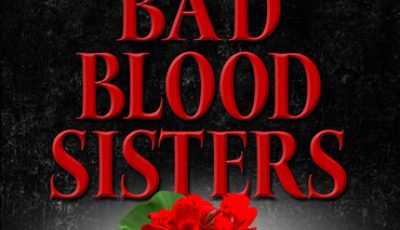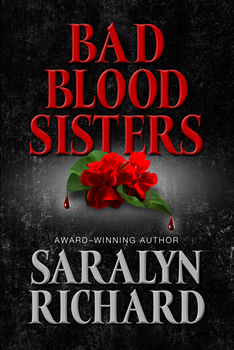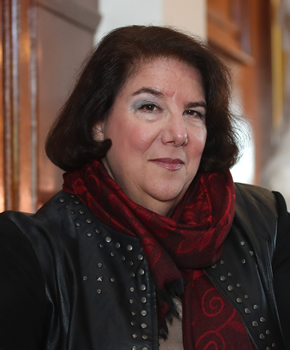

Bad Blood Sisters by Saralyn Richard
Quinn McFarland has always joked about death, but this summer, death stops being funny. For one thing, her brother finally undergoes transplant surgery. For another, Quinn’s estranged BFF, her “blood” sister, is brought into the family mortuary, bludgeoned to death.
In Saralyn Richard’s BAD BLOOD SISTERS, Quinn is haunted by the past, her friendship gone awry, and the blood oath she’s sworn to keep secret. The police consider her a person of interest, and someone threatens her not to talk. Quinn is the only one who knows enough to bring the killer to justice, but the secret she’s buried puts her in extreme danger.
The Big Thrill caught up with Richards to discuss her new book, the challenges about writing for adults and children, and her favorite kind of events.
You write for children and adults—what are the unique challenges of each?
My children’s book, Naughty Nana, is a 32-page picture book. Collaboration with the illustrator, Rebecca Evans, is a huge part of telling the story, and that means I have to be precisely conscious of every single word and its purpose on the page. The book has big ideas but small vocabulary, and the writing has to fit hand-in-glove with the illustrations. While that is a challenge, it is also a lesson in brevity that helps with my novel writing for adults.
In contrast, when writing adult mystery novels, I have the luxury of crafting as many chapters, scenes, or pages as I need to tell the story, but not so many that the pacing drags or causes the reader to lose interest. Having no illustrator, I must paint images with words. I need to achieve the right blend of action, exposition, and dialogue to keep the reader engaged and turning pages.
And what inspires the variety of stories you produce?
There’s a little bit of mystery in every genre of writing, and my favored genre is mystery. Some of my books are more humorous than others, and one is more of a thriller than the others, but all present a puzzle for readers to solve, a search for truth and justice, a restoration of order in the end. As for inspiration, I am usually drawn to a particular character in a particular situation/setting, and I play with the “what if” question. What if a guest at an elegant dinner party in a country mansion dies, and everyone at the party has a motive to kill him? What if a new principal with a student-centered agenda makes enemies his first day on the job? What if a young woman’s estranged BFF is killed? Answering the “what if” question becomes the basis for the story.
What is your favorite kind of event? Have you ever been completely thrown by a question?
I’m a real people person, and my favorite part of writing is connecting with readers. I’m happy to meet with people, whether in person or Zoom, indoors or outdoors, day or night. I’m comfortable talking about myself and my books, but my favorite part of any event is when I’m able to answer questions from the audience members. The questions are always so varied and interesting, and they give me insights into what readers care about.
Having had a career as an educator, I’ve had a lot of experience speaking before groups. (I even taught public speaking for a few years.) I don’t remember ever having been completely thrown by a question, but I was surprised when a friend asked me what a nice woman like me was doing writing books that contain violence. I reassured her that, like her, I abhor violence, but my novels, to quote P.D. James, “are not about violence. They are about the restoration of order.”
BAD BLOOD SISTERS has a great first line. “Quinn’s family always joked about death, but that summer, death stopped being funny.” Actually, the book’s got a great opening all around. How important is it that books grab a reader right from the start and what do you do to ensure that?
Thanks for the compliment. First lines can make or break the reader’s entry into the world of the book, not only literally, but also figuratively. I won’t elaborate on the obvious “grab-the-reader’s-attention-so-he-won’t-put-the-book-back-on-the-shelf” argument, but in a more global way, the opening of a book has to be strong enough to establish setting, character, voice, and tone. I wanted to put the reader into Quinn’s point of view at the exact moment when the falsely secure walls she has built around herself begin to crumble.
It’s very risky having animals in books as you can never hurt them. Is Calvin, from BAD BLOOD SISTERS, based on an actual dog, and how vital do you feel he is to the storyline?
The main characters in all of my books have pets (not all of them dogs), and I never thought of that as being risky. Often, the animals are characters in themselves with integral roles to play in the story, and they serve as a wonderful vehicle for bringing out the characteristics of the people.
In BAD BLOOD SISTERS, Calvin is the main character’s sidekick. After being betrayed by her boyfriend and her best friend, Quinn has trust issues with people, but the way she cares for her puppy foreshadows her potential for friendship and love. The need to take Calvin for walks and runs prevents Quinn from being a complete hermit, and it also puts her in compromised situations. Finally, Calvin has instinctual reactions to people and events that sometimes provide signals for the reader. He’s based on my own late West Highland terrier, so it was easy to portray the puppy from memory.
Sisterhood (born or chosen) is a powerful thing. I didn’t realize how powerful until we had our three daughters. What is it that makes that relationship so special?
Having never had a biological sister, I’ve always been intrigued by sisters and by the relationships between them. The sisters I’ve known have had intense feelings about one another—feelings of loyalty, protectiveness, friendship, and love, but also of competitiveness, envy, and resentment. I’ve been blessed with “chosen” sisters, sorority sisters, and I also have a “blood sister,” to whom I pledged eternal friendship when I was about eight years old. BAD BLOOD SISTERS gave me the opportunity to explore what makes sisters so special to one another. The strength of the relationship comes from shared experiences and relationships over a period of time, during which both parties grow and learn about themselves and each other. Most of the time, these relationships are nurturing, but, as Quinn points out throughout the book, even the best relationships can make a person vulnerable to heartache. Quinn’s struggle to make peace with her blood sister is at the heart of her own personal growth and identity.
*****
Award-winning mystery and children’s book author Saralyn Richard was born with a pen in her hand and ink in her veins. Winner of the Killer Nashville Silver Falchion Readers’ Choice Awards in 2019 and 2021, Richard’s Detective Parrott Mystery Series and standalones, A Murder of Principal and Bad Blood Sisters, pull back the curtain on people in settings as diverse as elite country manor houses and disadvantaged urban high schools.
An active member of International Thriller Writers and Mystery Writers of America, Saralyn teaches creative writing at the Osher Lifelong Learning Institute and continues to write mysteries.
Reviews, media, and tour schedule may be found on her website.
- The Deception by Kim Taylor Blakemore - September 30, 2022
- Death In The Aegean by M.A. Monnin - May 31, 2022
- Bad Blood Sisters by Saralyn Richard - February 28, 2022


